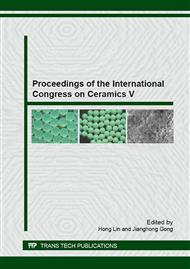[1]
F. Monteverde, S. Guicciardi, A. Bellosi, Advances in microstructure and mechanical properties of zirconium diboride based ceramics, Mater. Sci. Eng. A, 346 (2003) 310-319.
DOI: 10.1016/s0921-5093(02)00520-8
Google Scholar
[2]
W.G. Fahrenholtz, G.E. Hilmas, I.G. Talmy, J.A. Zaykoski, Refractory diborides of zirconium and hafnium, J. Am. Ceram. Soc., 90 (2007) 1347-1364.
DOI: 10.1111/j.1551-2916.2007.01583.x
Google Scholar
[3]
Jiecai Han, Ping Hu, Xinghong Zhang, S. Meng;, Oxidation behavior of zirconium diboride-silicon carbide at 1800°C, Scripta. Mater., (2007) 825-828.
DOI: 10.1016/j.scriptamat.2007.07.009
Google Scholar
[4]
F. Monteverde, A. Bellosi, S. Guicciardi, Processing and properties of zirconium diboride-based composites, J. Eur. Ceram. Soc., 22 (2002) 279-288.
DOI: 10.1016/s0955-2219(01)00284-9
Google Scholar
[5]
S.R. Levine, E.J. Opila, M.C. Halbig, J.D. Kiser, M. Singh, J.A. Salem, Evaluation of ultra-high temperature ceramics for aeropropulsion use, J. Eur. Ceram. Soc., 22 (2002) 2757-2767.
DOI: 10.1016/s0955-2219(02)00140-1
Google Scholar
[6]
A.L. Chamberlain, W.G. Fahrenholtz, G.E. Hilmas, D.T. Ellerby, High-strength zirconium diboride-based ceramics, J. Am. Ceram. Soc., 87 (2004) 1170-1172.
DOI: 10.1111/j.1551-2916.2004.01170.x
Google Scholar
[7]
X. Zhang, Q. Qu, J. Han, W. Han, C. Hong, Microstructural features and mechanical properties of ZrB2-SiC-ZrC composites fabricated by hot pressing and reactive hot pressing, Scripta. Mater., 59 (2008) 753-756.
DOI: 10.1016/j.scriptamat.2008.06.004
Google Scholar
[8]
Y. Zhao, L.J. Wang, G.J. Zhang, W. Jiang, L.D. Chen, Preparation and microstructure of a ZrB2-SiC composite fabricated by the spark plasma sintering-reactive synthesis (SPS-RS) method, J. Am. Ceram. Soc., 90 (2007) 4040-4042.
DOI: 10.1111/j.1551-2916.2007.02050.x
Google Scholar
[9]
Y.J. Yan, Z.R. Huang, S.M. Dong, D.L. Jiang, Pressureless sintering of high-density ZrB2-SiC ceramic composites, J. Am. Ceram. Soc., 89 (2006) 3589-3592.
DOI: 10.1111/j.1551-2916.2006.01270.x
Google Scholar
[10]
W.R. Pinc, M. Di Prima, L.S. Walker, Z.N. Wing, E.L. Corral, Spark Plasma Joining of ZrB2-SiC Composites Using Zirconium-Boron Reactive Filler Layers, J. Am. Ceram. Soc., 94 (2011) 3825-3832.
DOI: 10.1111/j.1551-2916.2011.04739.x
Google Scholar
[11]
B. Yuan, G. Zhang, Microstructure and shear strength of self-joined ZrB2 and ZrB2-SiC with pure Ni, Scripta Mater., 64 (2011) 4.
DOI: 10.1016/j.scriptamat.2010.08.056
Google Scholar
[12]
L. Esposito, A. Bellosi, Joining ZrB2-SiC composites using glass interlayers, J. Mater. Sci., 40 (2005) 4445-4453.
DOI: 10.1007/s10853-005-2813-y
Google Scholar
[13]
M.L. Muolo, E. Ferrera, R. Novakovic, A. Passerone, Wettability of ZrB2 ceramics by Ag, Cu and their alloys with Zr, Scripta Mater., 48 (2003) 6.
DOI: 10.1016/s1359-6462(02)00361-5
Google Scholar
[14]
A. Passerone, M.L. Muolo, R. Novakovic, D. Passerone, Liquid metal/ceramic interactions in the (Cu, Ag, Au)/ZrB2 systems, J. Eur. Ceram. Soc., 27 (2007) 9.
DOI: 10.1016/j.jeurceramsoc.2006.12.008
Google Scholar
[15]
M.L. Muolo, E. Ferrera, A. Passerone, Wetting and spreading of liquid metals on ZrB2-based ceramics, Proceedings of the IV international conference/High temperature capillarity, J. Mater. Sci., 2005, p.6.
DOI: 10.1007/s10853-005-1948-1
Google Scholar
[16]
R. Voytovych, A. Koltsov, F. Hodaj, N. Eustathopoulos, Reactive vs non-reactive wetting of ZrB2 by azeotropic Au-Ni, Acta. Mater., 55 (2007) 6.
DOI: 10.1016/j.actamat.2007.07.037
Google Scholar
[17]
F. Valenza, M.L. Muolo, A. Passerone, G. Cacciamani, C. Artini, Control of interfacial reactivity between ZrB2 and Ni-based brazing alloys, (2012).
DOI: 10.1007/s11665-012-0127-1
Google Scholar
[18]
A. Passerone, F. Valenza, M. L. Muolo, A review of transition metals diborides: from wettability studies to joining, J. Mater. Sci., Special editon: HTC, (2012).
DOI: 10.1007/s10853-012-6621-x
Google Scholar
[19]
M. Singh, R. Asthana, Joining and integration of ZrB2-based ultra-high temperature ceramic composites using advanced brazing technology, J. Mater. Sci., 45 (2010) 4308-4320.
DOI: 10.1007/s10853-010-4510-8
Google Scholar
[20]
M. Singh, R. Asthana, Joining of zirconium diboride-based ultra-high temperature ceramic composites using metallic glass interlayers, Mater. Sci. Eng. A, 460-461 (2007) 10.
DOI: 10.1016/j.msea.2007.01.015
Google Scholar
[21]
M. Singh, R. Asthana, Joining of ZrB2-Based Ultra-High-Temperature Ceramic Composites to Cu-Clad-Molybdenum for Advanced Aerospace Applications, Int. J. Appl. Ceram. Technol., 6 (2009) 113-133.
DOI: 10.1111/j.1744-7402.2008.02291.x
Google Scholar


